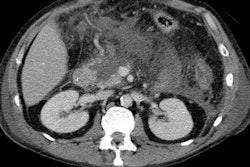Dear CT Insider,
Timing is everything when it comes to CT imaging of acute pancreatitis, and waiting 72 hours after the onset of symptoms produces the best results.
That's the view of Dutch radiologist Dr. Thomas Bellon from Utrecht. He gave a host of practical tips to a packed audience during last week's British Institute of Radiology annual congress in London. Our correspondent Becky McCall was onsite, and you can read her report here.
Computer-aided detection (CAD) of solid pulmonary nodules using CT with a radiation dose equivalent to chest x-ray has similar sensitivities to CAD of solid pulmonary nodules with standard-dose CT, according to Swiss researchers. At the 2016 annual meeting of the European Society of Thoracic Imaging in Krakow, Poland, the group won an award for the best oral presentation for this work. Find out more here.
Meanwhile, a group led by Dr. Marc Dewey in Berlin has compared coronary CT angiography (CCTA) directly with cardiac catheterization to look at diagnostic yields, major complications, and adverse events years later. CT was orders of magnitude more efficient in most categories, except radiation dose. Click here to get the full details.
Having examined 160 patients with CCTA and invasive coronary angiography, Austrian researchers have analyzed the nearly universal use of degree of stenosis to define coronary artery disease. They followed the patients to measure the predictive value of percent stenosis versus absolute lumen diameter. Get the results by clicking here.
The first anniversary of the Paris bombings is on 14 November. CT played a central role in caring for the victims. A year on, what lessons have been learned? Click here to find out.
This letter highlights just a few of the many articles posted in the CT Community. For the full list, please check out the lineup below.



















